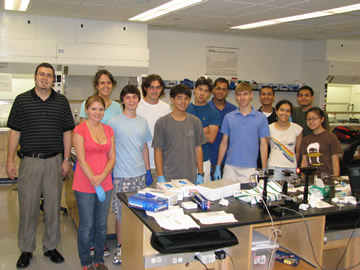 |
New Jersey Governor's School in the Sciences at Drew University |
 |
Drew Links |
|
| Team Projects | |
| NJGSS Home | |
| About NJGSS | |
Related Links |
|
| Drew University | |
2008 Team 2 |
||||||||
DEVELOPING PRACTICAL APPLICATIONS OF PHOSPHONIC ACID Skanda Amarnath, Matthew Chalkley, Rachel Chen, Reena Clements, Kevin Gu, Gawain Lau, Stephen Leh, Sarvagna Patel, Mark Vander Schaaf, Phyllis Schlafly, Smith Shah Advisor: Michael Avaltroni |
||||||||
ABSTRACTOxide surfaces make the application of any permanent coating extremely difficult because of the inherent inert nature of the surface. Thus, several anti-corrosion products that are typically applied post-production offer only short-term solutions as they only physically interact with the surfaces. Several variants of phosphonic acid present intriguing long-term solutions to corrosion through increased water resistance. The key lies in the substances' ability to bond chemically with inert oxide surfaces. The benefits of covalently bonding a coating to the oxide surface include increased bond strength, durability, and consistency. Through employing a simple spray-on and heat method to apply one variant of phosphonic acid, octadecylphosphonic acid (OPA), a self-assembling monolayer on the surface is sought for better resistance to different corrosion mechanisms. Tests were done on copper, stainless steel, and glass, three practical examples of common oxide surfaces. The corrosion methods are different based upon specific practical concerns for each material. Findings, from observation, attenuated total reflectance evaluations, and contact angle tests, show encouraging signs of OPA as a particularly effective chemical coating for promoting water-resistance and anti-corrosion. |
||||||||
|
||||||||
